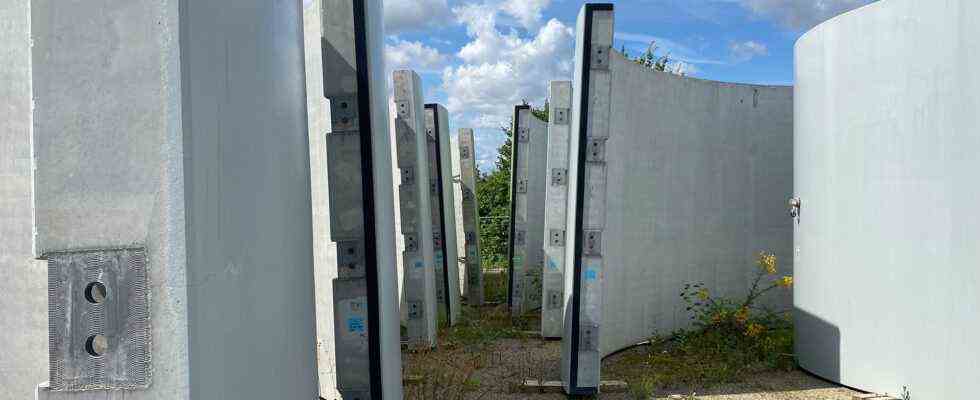Status: 08/15/2021 3:07 p.m.
Many Germans consider renewable energies important, but many reject wind turbines on their doorstep. Expansion projects are often on hold because of lawsuits – or because of a special rule, as examples from Franconia show.
The Lower Franconian community of Wülfershausen has long wanted to set up several wind turbines together with the neighboring town of Wargolshausen. There are to be two wind farms. The citizens have founded their own companies for the ten wind turbines. Money from power generation flows back into the community, and you feel more comfortable in the community with a local operator than with an unknown investor.
That sounds like mutual agreement and a positive example of a municipality that is committed to the energy transition and renewable energies. But there is a catch: Before the plans can become reality, eight brand new wind turbine foundations have to be demolished.
Years of history
Wülfershausen first received approval for its wind turbines in autumn 2014. Shortly afterwards, the “10-H rule” was introduced in Bavaria. It stipulates ten times the distance between the height of the wind turbine and the next residential building. The Bavarian state government under the then Prime Minister Horst Seehofer wanted to appease the wind power opponents. The provision in the Bavarian State Building Code only came into force in mid-November 2014.
Lawsuits through all instances
At that time, more than 1200 citizens opposed the wind farm project in Wülfershausen and Wargolshausen, founded citizens’ groups and sued through all instances. Much time passed. The Bavarian Administrative Court gave the green light for the construction on the edge of the Röhn in 2016.
Because of technical progress, the wind turbines approved at the time were already considered outdated, too maintenance-intensive and less efficient than those from another manufacturer. The court therefore also allowed an amendment to build another type of wind turbine. Accordingly, smaller, quieter and more efficient wind turbines could also be installed. Construction began – in autumn 2018 the foundations for the wind turbines were poured.
Again, opponents of wind power sued, this time against the Free State of Bavaria. According to the plaintiff’s argument, he shouldn’t have allowed the innovations from their point of view. The result: a construction freeze. The new foundations and wind turbine parts have been standing around useless since then.
Then, in the summer of 2020, the bang from the state parliament: The CSU majority passed the resolution that the municipalities may build the wind farm – but only with the wind turbines that were approved in 2014, i.e. the less efficient ones.
“Punch and Judy Theater beyond compare”
“This is a puppet theater beyond compare,” says Wülfershausen’s mayor, Wolfgang Seifert. “I also don’t know what went on in the minds of the MPs in the Bavarian state parliament to simply put an end to this project”. Because there is no longer a building permit for the foundations that have already been poured but are almost identical, they now have to be demolished and new ones poured.
This is incomprehensible to Mayor Seifert. He says he has never heard such contradicting statements in the context of a construction project. These years of back and forth cost a lot of time and money. The electricity customer will then have to pay the six million euros that have already been accrued when the wind farms are connected to the grid, according to Seifert.
Displeasure about exchange plans
The case of Lautertal in Upper Franconia is different: there, three wind turbines are to be replaced with new ones. After almost 20 years of operation and only one megawatt of electricity per year, they are considered unprofitable. But they are only 99 meters high including the rotor blade tip – that’s small in terms of wind turbine dimensions. Now they are to be exchanged for new, 250-meter-high wind turbines with six times more power. This is called “repowering”.
But there is resentment in the community with its more than 4,400 inhabitants. Two of the six districts are critical of repowering. The citizens would have got used to the sight of the existing wind turbines, according to Udo Oppel, spokesman for the Rottenbach district. But so far not a single wind turbine of this size has been installed in the entire region. There was a lack of empirical values with regard to shadows, noise and the effects on nature. This must be checked carefully.
Expansion in Bavaria almost came to a standstill
The planning of the municipality in the district of Coburg is still in its infancy. When replacing wind turbines, there may be an exception to the “10-H rule”. The municipality must ensure this within the framework of a so-called urban land-use plan. That means: It has to be in charge of everything from the citizen survey to the choice of location. That would be more effort, explains Lautertal’s first mayor, Karl Kolb, but the community could “have more say in terms of the number, the height of the wind turbines” and the distance between them.
Despite protests and lawsuits – the nationwide unique 10-H regulation still applies today. It has led to the fact that the expansion of wind power in Bavaria has almost come to a standstill since 2017. At the moment it does not look like it will be abolished. Nevertheless, Mayor Seifert does not believe that the rule can hold up for long. The Prime Minister cannot, on the one hand, hug trees and, on the other hand, continue to slow down the energy transition in Bavaria, he says. His congregation wants to make a contribution to leaving the world better than the younger generation found it.

